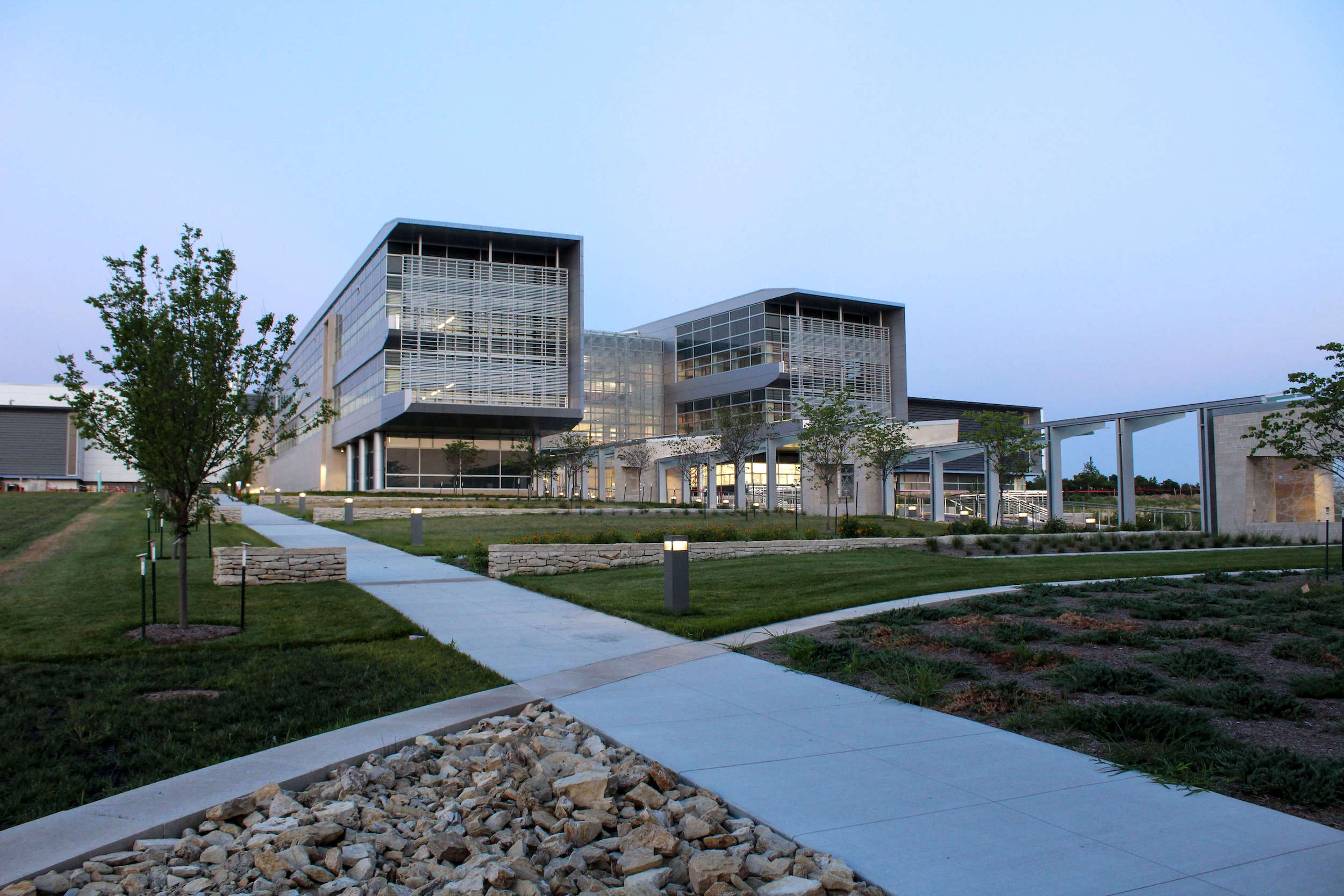In Manhattan, Kan., the National Bio and Agro-Defense Facility (NBAF), an animal disease research facility, has finished construction. Replacing the 68-year-old Plum Island Animal Disease Center, NBAF, when fully operational, will have labs functioning at multiple biosafety levels—including the nation’s first facility with biosafety level 4 containment capable of housing large livestock.
The 707,000-sf facility has been developed to ensure public health and the safety and security of the nation’s food supply. In 574,000 sf of lab space, scientists will safely study and diagnose high-consequence animal pathogens. In addition, an 87,000-sf utility plant houses boilers, chillers, emergency diesel generators, and other support elements for the main lab facility.
In addition to its state-of-the-art laboratories, NBAF will have a Biologics Development Module to explore potential vaccines, diagnostic platforms, and veterinary medical countermeasures.
With construction complete, the U.S. Department of Agriculture has begun to assume control of NBAF from the Department of Homeland Security Science and Technology Directorate. This involves confirming laboratory setup and making sure the equipment functions properly. “These are critical initial steps to ensure all research and diagnostics can be accomplished safely and effectively,” Ken Burton, NBAF deputy director, said in a statement.
The preconstruction, construction, and commissioning contract was valued at $1.06 billion. Despite pandemic-related challenges and delays, the project with commissioning came in under the $1.25 billion budget established by federal officials in 2014.
On the Building Team:
Owner/developer: U.S. Department of Homeland Security Science and Technology Directorate, which turned over operational responsibility to U.S. Department of Agriculture
Design team: NBAF Design Partnership JV (Perkins&Will, Flad Architects, Affiliated Engineers, WSP, and Merrick & Company)
Design architect: Perkins&Will
Architects of record: Perkins&Will and Flad Architects
MEP engineers: Affiliated Engineers, Inc., WSP, and Merrick & Company
Structural engineers: IMEG Corp. and Flad Architects
Construction manager: McCarthy Mortenson JV (McCarthy Building Companies, Inc. and Mortenson Construction)
Related Stories
BIM and Information Technology | May 8, 2023
3 ways computational tools empower better decision-making
NBBJ explores three opportunities for the use of computational tools in urban planning projects.
Mass Timber | May 1, 2023
SOM designs mass timber climate solutions center on Governors Island, anchored by Stony Brook University
Governors Island in New York Harbor will be home to a new climate-solutions center called The New York Climate Exchange. Designed by Skidmore, Owings & Merrill (SOM), The Exchange will develop and deploy solutions to the global climate crisis while also acting as a regional hub for the green economy. New York’s Stony Brook University will serve as the center’s anchor institution.
University Buildings | Apr 24, 2023
Solving complicated research questions in interdisciplinary facilities
University and life science project owners should consider the value of more collaborative building methods, close collaboration with end users, and the benefits of partners who can leverage sector-specific knowledge to their advantage.
Laboratories | Mar 9, 2023
5 laboratory design choices that accelerate scientific discovery
Stephen Blair, director of CannonDesign's Science & Technology Practice, identifies five important design strategies to make the most out of our research laboratories.
University Buildings | Feb 9, 2023
3 ways building design can elevate bold thinking and entrepreneurial cultures
Mehrdad Yazdani of CannonDesign shares how the visionary design of a University of Utah building can be applied to other building types.
Giants 400 | Feb 9, 2023
New Giants 400 download: Get the complete at-a-glance 2022 Giants 400 rankings in Excel
See how your architecture, engineering, or construction firm stacks up against the nation's AEC Giants. For more than 45 years, the editors of Building Design+Construction have surveyed the largest AEC firms in the U.S./Canada to create the annual Giants 400 report. This year, a record 519 firms participated in the Giants 400 report. The final report includes 137 rankings across 25 building sectors and specialty categories.
University Buildings | Feb 7, 2023
Kansas City University's Center for Medical Education Innovation can adapt to changes in medical curriculum
The Center for Medical Education Innovation (CMEI) at Kansas City University was designed to adapt to changes in medical curriculum and pedagogy. The project program supported the mission of training leaders in osteopathic medicine with a state-of-the-art facility that leverages active-learning and simulation-based training.
Mass Timber | Jan 30, 2023
Net-positive, mass timber building will promote research on planetary well-being in Barcelona
ZGF Architects, along with Barcelona-based firms MIRAG and Double Twist, have designed a net-positive, mass timber center for research on planetary well-being. Located in Barcelona, the Mercat del Peix Research Center will bring together global experts in the experimental sciences, social sciences, and humanities to address challenges related to the future of the planet.
Adaptive Reuse | Dec 21, 2022
University of Pittsburgh reinvents century-old Model-T building as a life sciences research facility
After opening earlier this year, The Assembly recently achieved LEED Gold certification, aligning with the school’s and community’s larger sustainability efforts.
Data Centers | Nov 28, 2022
Data centers are a hot market—don't waste the heat!
SmithGroup's Brian Rener shares a few ways to integrate data centers in mixed-use sites, utilizing waste heat to optimize the energy demands of the buildings.

















